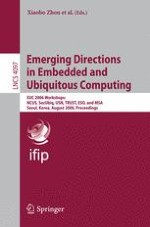2006 | Buch
Emerging Directions in Embedded and Ubiquitous Computing
EUC 2006 Workshops: NCUS, SecUbiq, USN, TRUST, ESO, and MSA, Seoul, Korea, August 1-4, 2006. Proceedings
herausgegeben von: Xiaobo Zhou, Oleg Sokolsky, Lu Yan, Eun-Sun Jung, Zili Shao, Yi Mu, Dong Chun Lee, Dae Young Kim, Young-Sik Jeong, Cheng-Zhong Xu
Verlag: Springer Berlin Heidelberg
Buchreihe : Lecture Notes in Computer Science
